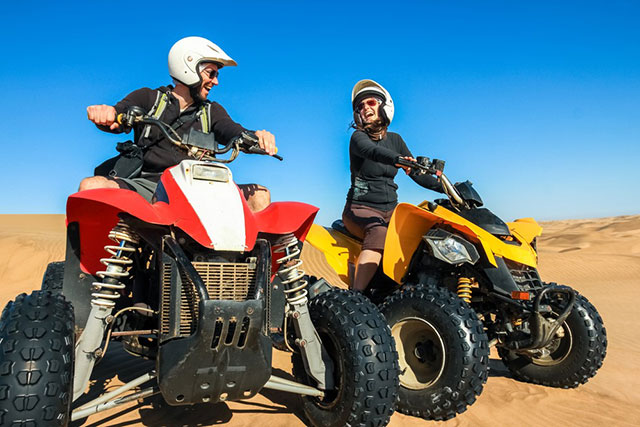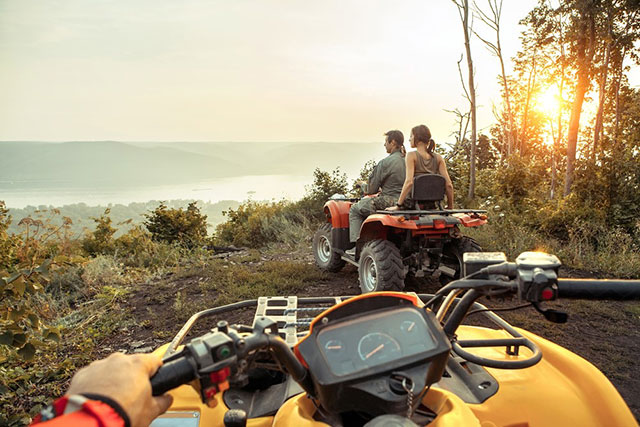Looking to take a trip on your all-terrain vehicle? Most of us associate ATVs with short-distance runs like day riding, but some people love to take them on overnight trips because it lets them leave the road behind. And if you can’t transport your ATV, there are bound to be plenty of rental options at your destination. That’s where the adventure begins.
It’s important to note that ATVs aren’t always built for long-distance riding. The driving range depends on the make and model. Smaller engines in the 250 cc to 500 cc range can go anywhere from 50 to 100 miles, and larger engines at 750 cc can go up to 150 miles. Once you have your vehicle in order, stock up on all the best ATV riding gear to make sure you can reach your destination in one piece. The natural world can be anything but predictable, so it’s best to overprepare rather than hope for the best.

Before you hit the road to your ATV trail destination, use this packing list to prepare for your trip.
Table of Contents
1. Proper Clothing and Safety Gear
You shouldn’t ride your ATV without the proper safety gear. That means wearing a full-face or half-face helmet with goggles to protect your eyes, face and head. Cover your skin with long sleeves and pants, even if it’s hot outside. The clothes should be durable enough to stand up to stray twigs, flying rocks, dirt and other debris. If you plan on riding through rugged territory, bring along knee and shoulder pads to reduce your risk of injury in the event of a fall. Wear riding gloves to keep a firm grip on the handlebars and comfortable riding boots that will keep your feet warm and dry in the wilderness.
2. Wireless Communication
Riding is more fun when you’re with a group. ATVs can only fit one person at a time, so you will each need your own vehicle. The path can be narrow, so you may need to ride in single-file formation in many sections. Use off-road communication to talk to your companions in real-time without taking your eyes off the road or your hands off the handlebars. It attaches right to your helmet, so you can coordinate your location when in range. The person in front can warn the following riders of potential hazards and obstacles that should be avoided. If someone needs a break, all they have to do is speak up.
3. Spare Fuel
ATVs aren’t exactly known for their fuel efficiency. Most makes and models get around 20 miles per gallon. Check the fuel capacity of your tank to see how far you can get on a single tank. Bring at least one spare container of fuel on top of your regular supply in case you get lost.
4. First Aid Kit

The wilderness can be an unforgiving host. All that time off-road can also lead to aches and pains, so make sure you have everything you need to respond to an emergency in the wild. Bring a first aid kit complete with over-the-counter medications, gauze, bandages and bug spray — lots of bug spray.
5. Travel Pack
We’re just getting started, and you’re probably already running out of space in your pack. Attach a rear seat storage bag to make some extra room for all these essentials. You don’t want to put too much weight on your back when your vehicle can do the heavy lifting instead.
6. Camping Equipment
Make space for all your camping essentials if you plan on going off-road for more than one day at a time. An ATV will help you reach all kinds of remote camping destinations with plenty of peace and quiet. Bring along everything you need to sleep under the stars, including a compact tent, sleeping bag and an emergency blanket to keep you warm at night.
7. Navigation Tools
It’s easy to get lost when exploring off-road. There aren’t any roads to follow, and you might not get a signal on your GPS or smartphone. You should prepare yourself to navigate without the use of technology. That means having a compass and paper maps on hand. You also need to know how to use these tools in an emergency. Mark your path on the map ahead of time and tell the local rangers or property owners where you’re going. You can also bring a radio to call for help in an emergency.

8. Spare Clothes
Your clothes are bound to get dirty after a few hours of riding. Mud and dirt will fly through the air, leaving you feeling crusty at the end of the day. Bring several changes of clothing in case you make a wrong turn through a mossy bog or an especially deep puddle of mud. You may like to make a mess when you ride, but be sure to put on fresh clothes if you have any open wounds to avoid getting an infection. Your body temperature will also drop when the sun goes down if your clothes are still wet.
There’s so much earth out there to explore, especially when you decide to leave the road behind. The possibilities are truly endless. All you need is the right gear and a well-maintained all-terrain vehicle.













